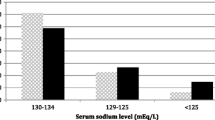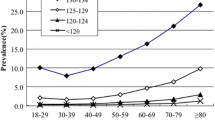Abstract
Hypernatremia develops commonly in critically ill patients during hospitalization, and is associated with adverse outcomes. However, community acquired hypernatremia (CAH) has been rarely studied. We conducted a study in patients who presented to an urban referral hospital, and were admitted with CAH. We retrospectively analyzed patients admitted to an urban tertiary care hospital from January 1, 2012 to December 31, 2014. CAH is defined as more than 147 mEq/L at admission in patients not transferred from other hospitals. Severity of hypernatremia is categorized as mild (148–150 mEq/L), moderate (151–154 mEq/L) or severe (≥155 mEq/L). All data were extracted from electronic medical records and the major outcome is hospital mortality. During the study period, 79,998 patients were admitted to the hospital. Of them, 178 patients (0.2%) had hypernatremia at the time of admission. 121 (68.0%) had mild hypernatremia, 33 (18.5%) had moderate hypernatremia, and 24 (13.5%) had severe hypernatremia at admission. During the hospital stay, 91 (51.1%) developed mild hypernatremia, 31 (17.4%) developed moderate hypernatremia and 56 (31.5%) developed severe hypernatremia. Mean duration of hypernatremia was 2.3 ± 2.0 days. The length of hospital stay was 7 (interquartile range 3–23) days and hospital mortality was 24.3%. Multivariate analysis shows that a peak sodium level that qualified as moderate [OR = 11.50, 95% CI (2.67–49.42)] or severe hypernatremia [OR = 5.18, 95% CI (1.43–18.79)] is an independent risk factor for hospital mortality compared to mild hypernatremia. Admission from the emergency department (ED), oral intake restriction, mean arterial pressure (MAP) and respiratory rate (RR) at admission time are also independently associated with hospital mortality. Maximum sodium level in CAH is independently associated with hospital mortality.

Similar content being viewed by others
References
Adrogue HJ, Madias NE (2000) Hypernatremia. N Engl J Med 342(20):1493–1499. doi:10.1056/NEJM200005183422006
Asadollahi K, Hastings IM, Beeching NJ, Gill GV (2007) Laboratory risk factors for hospital mortality in acutely admitted patients. QJM 100(8):501–507. doi:10.1093/qjmed/hcm055
Lindner G, Funk GC, Schwarz C, Kneidinger N, Kaider A, Schneeweiss B, Kramer L, Druml W (2007) Hypernatremia in the critically ill is an independent risk factor for mortality. Am J Kidney Dis 50(6):952–957. doi:10.1053/j.ajkd.2007.08.016
O’Donoghue SD, Dulhunty JM, Bandeshe HK, Senthuran S, Gowardman JR (2009) Acquired hypernatraemia is an independent predictor of mortality in critically ill patients. Anaesthesia 64(5):514–520. doi:10.1111/j.1365-2044.2008.05857.x
Whelan B, Bennett K, O’Riordan D, Silke B (2009) Serum sodium as a risk factor for in-hospital mortality in acute unselected general medical patients. QJM 102(3):175–182. doi:10.1093/qjmed/hcn165
Darmon M, Timsit JF, Francais A, Nguile-Makao M, Adrie C, Cohen Y, Garrouste-Orgeas M, Goldgran-Toledano D, Dumenil AS, Jamali S, Cheval C, Allaouchiche B, Souweine B, Azoulay E (2010) Association between hypernatraemia acquired in the ICU and mortality: a cohort study. Nephrol Dial Transplant 25(8):2510–2515. doi:10.1093/ndt/gfq067
Frenkel WNJ, Born B-JHvd, Munster BCv, Korevaar JC, Levi M, Rooij SEd (2010) The association between serum sodium levels at time of admission and mortality and morbidity in acutely admitted elderly patients: a prospective cohort study. J Am Geriatr Soc 58:2227–2257
Leung AA, McAlister FA, Finlayson SR, Bates DW (2013) Preoperative hypernatremia predicts increased perioperative morbidity and mortality. Am J Med 126(10):877–886. doi:10.1016/j.amjmed.2013.02.039
Waite MD, Fuhrman SA, Badawi O, Zuckerman IH, Franey CS (2013) Intensive care unit-acquired hypernatremia is an independent predictor of increased mortality and length of stay. J Crit Care 28(4):405–412. doi:10.1016/j.jcrc.2012.11.013
Funk GC, Lindner G, Druml W, Metnitz B, Schwarz C, Bauer P, Metnitz PG (2010) Incidence and prognosis of dysnatremias present on ICU admission. Intensive Care Med 36(2):304–311. doi:10.1007/s00134-009-1692-0
Vandergheynst F, Sakr Y, Felleiter P, Hering R, Groeneveld J, Vanhems P, Taccone FS, Vincent JL (2013) Incidence and prognosis of dysnatraemia in critically ill patients: analysis of a large prevalence study. Eur J Clin Invest 43(9):933–948. doi:10.1111/eci.12123
Kovesdy CP, Lott EH, Lu JL, Malakauskas SM, Ma JZ, Molnar MZ, Kalantar-Zadeh K (2012) Hyponatremia, hypernatremia, and mortality in patients with chronic kidney disease with and without congestive heart failure. Circulation 125(5):677–684. doi:10.1161/CIRCULATIONAHA.111.065391
Bataille S, Baralla C, Torro D, Buffat C, Berland Y, Alazia M, Loundou A, Michelet P, Vacher-Coponat H (2014) Undercorrection of hypernatremia is frequent and associated with mortality. BMC Nephrol 15:37. doi:10.1186/1471-2369-15-37
Bihari S, Peake SL, Bailey M, Pilcher D, Prakash S, Bersten A (2014) Admission high serum sodium is not associated with increased intensive care unit mortality risk in respiratory patients. J Crit Care 29(6):948–954. doi:10.1016/j.jcrc.2014.06.008
Wolff A, Stuckler D, McKee M (2015) Are patients admitted to hospitals from care homes dehydrated? A retrospective analysis of hypernatraemia and in-hospital mortality. J R Soc Med 108(7):259–265. doi:10.1177/0141076814566260
Liamis G, Tsimihodimos V, Doumas M, Spyrou A, Bairaktari E, Elisaf M (2008) Clinical and laboratory characteristics of hypernatraemia in an internal medicine clinic. Nephrol Dial Transplant 23(1):136–143. doi:10.1093/ndt/gfm376
Funk G-C, Lindner G, Druml W, Metnitz B, Schwarz C, Bauer P, Metnitz PGH (2010) Incidence and prognosis of dysnatremias present on ICU admission. Intensive Care Med 36:304–311. doi:10.1007/s00134-009-1692-0)
Hu B, Han Q, Mengke N, He K, Zhang Y, Nie Z, Zeng H (2016) Prognostic value of ICU-acquired hypernatremia in patients with neurological dysfunction. Medicine (Baltimore) 95(35):e3840. doi:10.1097/MD.0000000000003840
Ates I, Ozkayar N, Toprak G, Yilmaz N, Dede F (2016) Factors associated with mortality in patients presenting to the emergency department with severe hypernatremia. Intern Emerg Med 11(3):451–459. doi:10.1007/s11739-015-1368-4
Deubner N, Berliner D, Frey A, Guder G, Brenner S, Fenske W, Allolio B, Ertl G, Angermann CE, Stork S (2012) Dysnatraemia in heart failure. Eur J Heart Fail 14:1147–1154. doi:10.1093/eurjhf/hfs115
Nguyen NQ, Besanko LK, Burgstad C, Bellon M, Holloway RH, Chapman M, Horowitz M, Fraser RJ (2012) Delayed enteral feeding impairs intestinal carbohydrate absorption in critically ill patients. Crit Care Med 40(1):50–54. doi:10.1097/CCM.0b013e31822d71a6
Alshayeb HM, Showkat A, Babar F, Mangold T, Wall BM (2011) Severe hypernatremia correction rate and mortality in hospitalized patients. Am J Med Sci 341(5):356–360. doi:10.1097/MAJ.0b013e31820a3a90
Lien YH, Shapiro JI, Chan L (1990) Effects of hypernatremia on organic brain osmoles. J Clin Invest 85(5):1427–1435. doi:10.1172/JCI114587
Acknowledgements
This work was supported by the Soonchunhyang University Research Fund.
Author information
Authors and Affiliations
Corresponding author
Ethics declarations
Conflict of interest
No potential conflict of interest relevant to this article was reported.
Statement of human and animal rights
All procedures performed in studies involving human participants were in accordance with the ethical standards of the institutional or national research committee and with the 1964 Helsinki declaration and its later amendments or comparable ethical standards.
Informed consent
Informed consent was waived because this was an anonymous observational study and no extra blood sample obtained.
Rights and permissions
About this article
Cite this article
Jung, W.J., Lee, H.J., Park, S. et al. Severity of community acquired hypernatremia is an independent predictor of mortality. Intern Emerg Med 12, 935–940 (2017). https://doi.org/10.1007/s11739-017-1673-1
Received:
Accepted:
Published:
Issue Date:
DOI: https://doi.org/10.1007/s11739-017-1673-1




